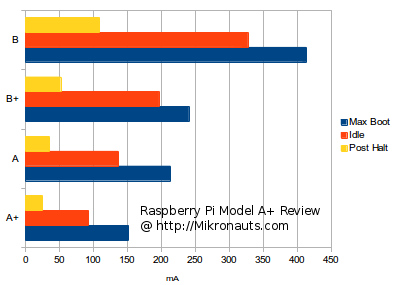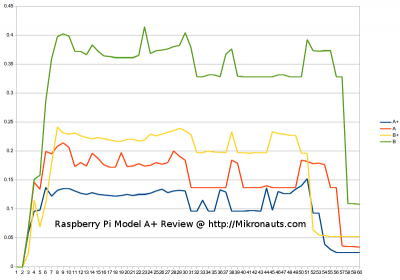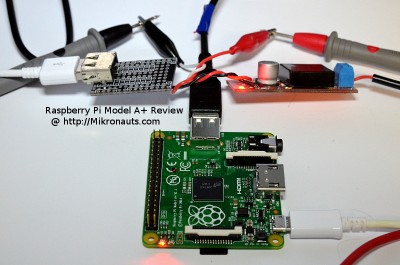Raspberry Pi Model A+ Review
Test Results
In the table below, all results are in milli-Amps (mA)
| Model | Max Boot | Idle | Post Halt |
| A+ | 152 | 96 | 25 |
| A | 214 | 137 | 35 |
| B+ | 241 | 197 | 52 |
| B | 414 | 328 | 109 |
The Raspberry Pi Model A+ has the best (lowest) power consumption of all four models tested!
I am still somewhat troubled about the post-halt current consumption, as 25mA adds up over time.
The bar chart makes the difference in power consumption quite obvious.
(click on the image for a larger version)
I plotted the logged power consumption for the tests, and created an overlapping chart of the results.
As I am merely human, I could not align the phases (boot, log in, sudo halt, halted) perfectly, and I moved some of the of the data so that it would line up fairly well. The power savings of the Raspberry Pi Model A+ are very evident here.
Conclusion
The new Raspberry Pi Model A+ is a great addition to the Raspberry Pi Foundation’s line-up of low cost educational single board computers.
The low power consumption – and extremely low cost – makes it ideal for a lot of embedded applications.
It can also be an excellent educational computer when equipped with a powered USB hub – but frankly, the Model B+ with twice the ram and four USB ports is a much better choice as a non-embedded educational computer.
(click on the image for larger version)
What I liked about the new Raspberry Pi Model A+
- better power supply
- VERY low power consumption
- 5 more available I/O than Model A (as rev.2 had four I/O’s on P5)
- micro SD
- four mounting holes
- smaller form factor
- 99% software compatibility (1% off for no P5 I/O’s)
- good hardware compatibility
- LOWER PRICE
What I did not like about the Raspberry Pi Model A+
- the full schematic is not available
- amount of current used when the Pi is “turned off” is still more than I like
- loss of GPIO formerly on P5
Not releasing full schematics is an issue for advanced users, especially as the Raspberry Pi Model A+ is so suitable for embedding into devices and will likely be used for IoT often. There is no valid reason for not releasing the schematics – the Broadcomm chip can only be purchased in vast volumes (as witnessed by the death of the Odroid-W), and any “clones” using a different processor are not really clones as they cannot run all Pi software. I am hoping that the Raspberry Pi Foundation will release the full schematics soon.
As a highly technical user, I am looking forward to embedding the Model A+ for all sorts of interesting applications!
If I had to give the Raspberry Pi Model A+ a numeric rating, I’d rate the new Rasberry Pi Model A+ at 95% – a $25 512MB version would have scored 99%
VERY Well done!
Related Links
- Raspberry Pi Model B+ Review
- Model 40 Pin GPIO pinout at the Raspberry Pi Foundation
- Raspberry Pi 16×2 and 20×4 LCD Interfacing
- Raspberry Pi Camera Adventures
- Elf 2WD Raspberry Pi based Robot
- RoboPi Advanced Robot Controller for the Raspberry Pi
- Pi Jumper breakout with 5V I2C for the Raspberry Pi
- Pi Rtc Dio digital I/O expansion, Real Time Clock and prototyping for the Raspberry Pi
- EZasPi prototyping board for the Raspberry Pi
- Raspberry Pi Model A+ product page at the Raspberry Pi Foundation
Article Index


